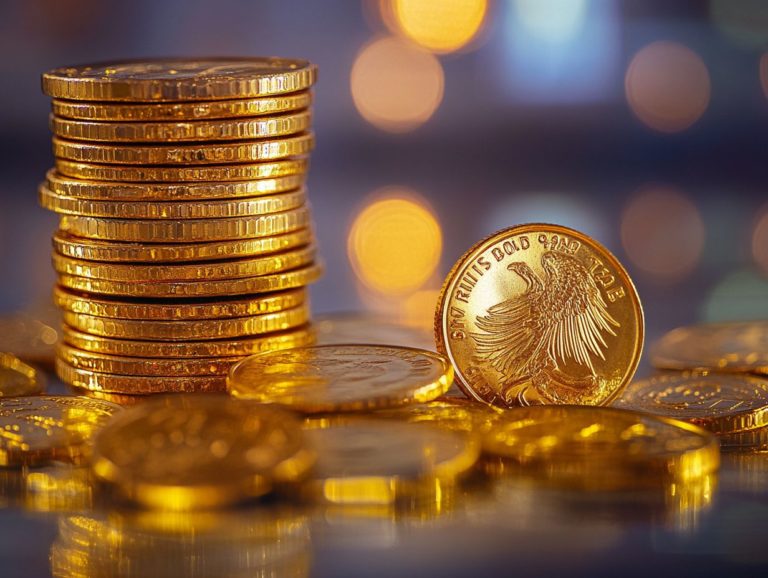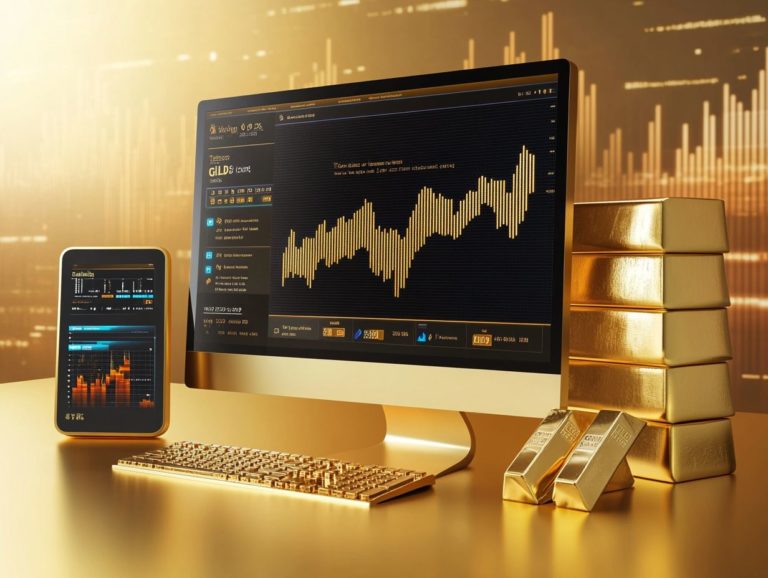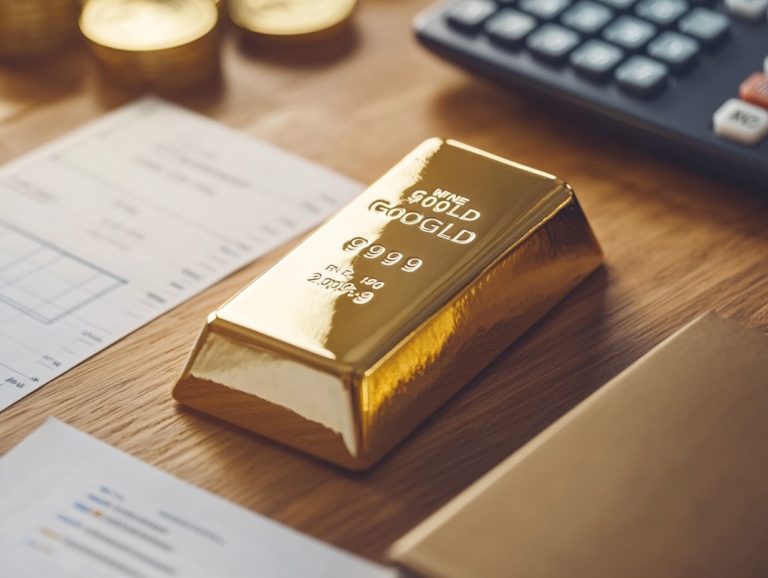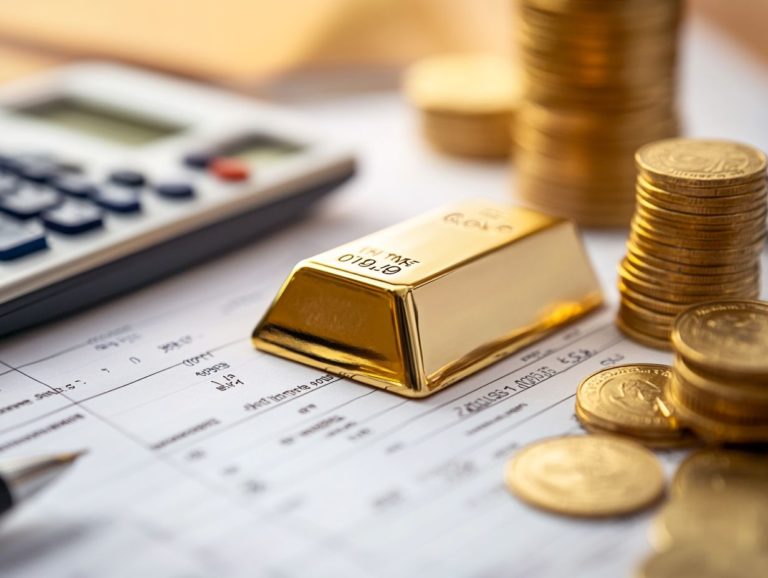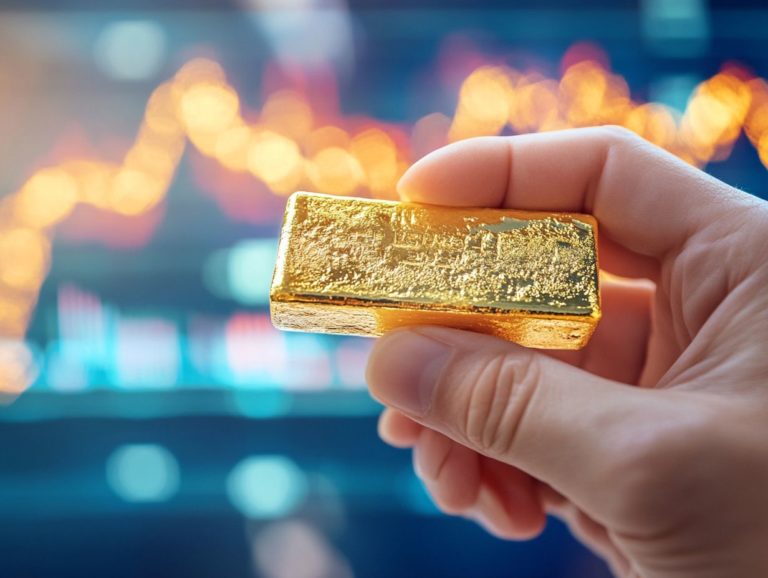Gold Price Fluctuations: Causes and Effects
Gold has long held the status of a safe haven for investors, yet its prices can be anything but stable. Grasping the factors that drive these fluctuations is essential for anyone aiming to navigate the gold market with confidence.
This article delves into the myriad influences on gold prices, examines historical trends, and underscores the impact on both the economy and individual investments. With insights into forecasting methods and risk management strategies, you will be empowered to make informed decisions in the dynamic realm of gold investment.
Contents
- Key Takeaways:
- Understanding Gold Price Fluctuations
- Historical Trends in Gold Prices
- Impact of Gold Price Fluctuations
- Predicting Gold Price Fluctuations
- Managing Risks in Gold Investments
- Frequently Asked Questions
- What causes gold prices to fluctuate?
- How do economic conditions impact the price of gold?
- What role do political events play in gold price fluctuations?
- How do interest rates affect the price of gold?
- What is the effect of investor demand on gold prices?
- How do gold price fluctuations impact the economy?
Key Takeaways:

- Gold prices are influenced by economic conditions, supply and demand, and geopolitical events.
- Historical trends reveal that gold prices can be volatile, especially during economic instability.
- Price fluctuations affect inflation, currency values, and various industries.
Understanding Gold Price Fluctuations
Understanding the fluctuations in gold prices is vital for you as an investor aiming to navigate the intricate landscape of financial markets. Gold has always been seen as a safe haven asset, especially in times of economic uncertainty. The relationship between demand from central banks, shifts in the U.S. dollar, inflation trends, and how much gold is being mined all play a significant role in gold’s historical performance.
Moreover, options like exchange-traded funds (ETFs), the demand for jewelry, and geopolitical events can lead to notable price swings. You must closely monitor market conditions and supply metrics to effectively anticipate future trends.
Factors that Influence Gold Prices
Various factors significantly influence gold prices, making it essential for you to stay informed about market dynamics. Key elements include the demand for gold from central banks, the strength of the U.S. dollar, and inflation rates, all of which can directly impact your investment decisions.
Supply factors, like mining production levels, play a crucial role in shaping price movements. Investment trends in ETFs, which have gained popularity as a means of gaining exposure to gold, further contribute to the fluctuations in price. Another important aspect you should consider is the geopolitical climate; tensions and uncertainties often drive investors like you toward gold as a safe-haven asset.
For instance, during economic crises such as the 2008 financial meltdown, gold prices surged, underscoring its role as a hedge against economic instability. Changes in interest rates set by central banks can alter the opportunity cost of holding gold, affecting its appeal compared to interest-bearing assets.
Historical analysis shows that when inflation outpaces interest rates, gold often benefits, making it a preferred choice for those looking to preserve wealth. Understanding these connections empowers you to make informed decisions in the ever-changing gold market.
Historical Trends in Gold Prices
Analyzing historical trends in gold prices offers you a treasure trove of insights into its role as both an investment vehicle and a safe haven asset. Consider the significant price fluctuations during critical moments, such as the financial crisis of 2008, which spurred an increased demand for gold as a hedge against economic uncertainty.
Events like the abandonment of the gold standard, along with sharp price shifts in August 2020, September 2011, and December 2015, underscore gold’s volatility and the impact of external influences such as inflation and geopolitical tensions.
By understanding these historical patterns, as detailed by the World Gold Council, you can better shape your future investment strategies and align your expectations accordingly.
Key Events and Patterns

Key events and patterns have historically shaped the trajectory of gold prices. This positions gold as a reliable barometer for economic health. When major geopolitical events occur, spikes in gold demand often follow, as investors seek stability amid uncertainty.
Financial crises consistently trigger price surges, underscoring gold’s role as a safe haven.
The World Gold Council offers valuable insights into these dynamics. Events such as economic downturns or policy shifts can significantly influence market behavior and investment trends.
Take, for instance, the 2008 financial crisis. During that time, gold prices skyrocketed from around $800 per ounce to over $1,900 by 2011. This showcases the heavy appetite for gold during turbulent times. Geopolitical tensions, like the U.S.-China trade disputes and the recent invasion of Ukraine, have also led to significant short-term price fluctuations.
Analysts have observed a dramatic uptick in gold purchases linked to central banks adjusting their monetary policies or accumulating reserves in response to global instability.
In fact, according to the latest statistics, central banks collectively purchased over 400 tons of gold in 2022. This reinforces the metal’s enduring appeal as a hedge against inflation and currency devaluation.
Impact of Gold Price Fluctuations
Have you ever wondered how gold prices influence your investments? The influence of gold price fluctuations reaches well beyond the allure of the metal itself.
These fluctuations intricately weave into the broader economy and shape diverse investment strategies.
When gold is perceived as a safe haven, its soaring prices amid economic uncertainty can serve as a telltale sign of problems in cash availability in other markets. This prompts investors to seek a more stable investment landscape.
Notable changes in gold prices can impact the demand for gold-related investment products, like exchange-traded funds (ETFs) and mining stocks. This ultimately reshapes your portfolio and strategic approach.
Grasping these implications is essential for anyone, whether you re an individual or part of an institutional framework, navigating ever-evolving market conditions.
Effects on Economy and Investments
Fluctuations in gold prices have significant implications for both the economy and individual investments. During financial crises, when gold prices rise, it often signals a flight to safety. This prompts central banks to refine their reserve strategies and urges investors to rethink their portfolios.
This shift can spark heightened interest in gold-related investment products, such as ETFs, as investors seek to hedge against economic instability. Understanding these patterns is essential for informed investment decisions in a volatile market.
Central banks recognize gold’s pivotal role in global finance and may modify their buying and selling tactics to stabilize their currencies. For example, in 2020, when gold prices soared beyond $2,000 per ounce, several central banks, including those of Russia and Turkey, significantly increased their gold purchases to reinforce reserves and protect against currency depreciation. This trend highlights a broader strategy nations employ to hedge against inflation and manage risks tied to geopolitical uncertainties.
Gold s reputation as a safe haven encourages retail investors to redirect funds from equities into physical gold or gold-backed securities. This further shapes market behaviors and influences price movements.
Predicting Gold Price Fluctuations
Predicting gold price fluctuations is no small feat. It demands keen analysis of diverse market conditions and economic indicators.
As an investor, you often rely on historical data, trends, and sophisticated forecasting models to anticipate future price movements.
Crucial factors come into play, including geopolitical tensions, inflation rates, and liquidity within global markets. All of these significantly influence your expectations surrounding gold prices.
By grasping these elements, you can strategically position yourself in an ever-evolving financial landscape.
Stay informed about gold price trends and consider how they fit into your investment strategies!
How to Forecast Gold Prices Effectively
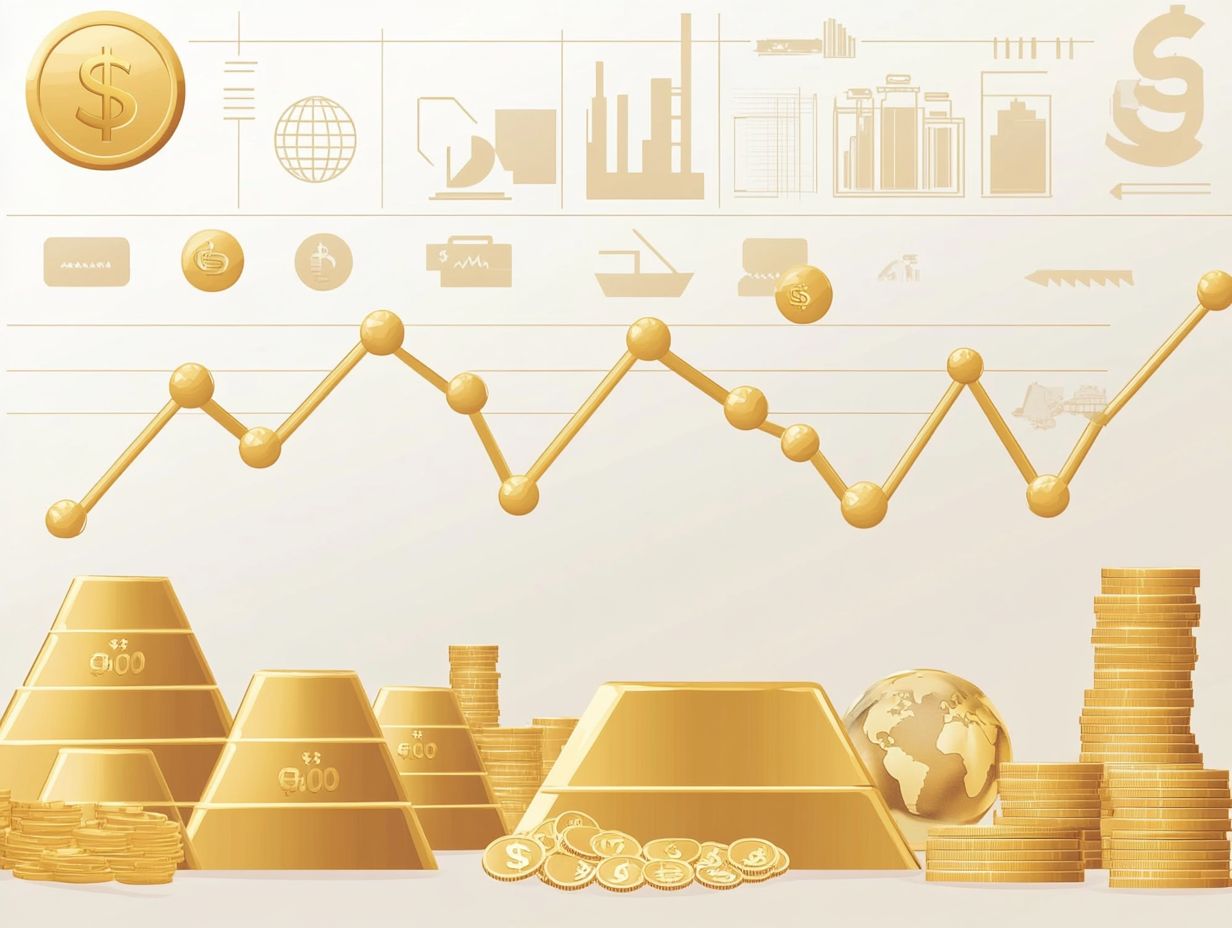
Various methods and tools are employed to forecast gold prices, each offering unique insights into market conditions. Technical analysis delves into historical price trends and patterns. It is often used alongside fundamental analysis, which focuses on economic indicators like inflation and demand.
By integrating these methods, you can develop a nuanced understanding of potential price movements. This helps you make informed decisions about your gold investments.
For instance, technical analysts frequently use charting tools and indicators like moving averages and Relative Strength Index (RSI) to pinpoint trends and potential reversal points in the gold market. In contrast, fundamental analysts monitor factors like geopolitical events, shifts in interest rates, and currency fluctuations that significantly influence the demand for gold.
Both approaches empower you to gauge market sentiment and the overall economy, enhancing your ability to anticipate shifts in gold prices and seize profitable trading opportunities.
Managing Risks in Gold Investments
Managing risks in gold investments is crucial for protecting your capital and optimizing returns in a volatile market. Consider using various risk management strategies, such as diversifying across different assets and sectors, to help reduce exposure to price fluctuations.
You can also utilize hedging strategies with financial instruments to shield yourself from adverse price movements. This ensures that gold remains a strategic element in your well-rounded investment portfolio. Mastering these techniques can empower you to navigate the complexities of gold investing with confidence and skill!
Diversification and Hedging Strategies
Diversification and hedging strategies are essential pillars of effective investment management in the gold market. By spreading your investments across various asset classes, you can help reduce the risks of changing gold prices. Hedging further strengthens your defenses against unfavorable market conditions.
Consider employing a range of financial instruments, such as options and futures, as hedging tools to stabilize your returns and minimize the risks inherent in gold investments.
For example, you could enhance your gold portfolio by adding stocks in mining companies or exchange-traded funds (ETFs) that track diverse commodities. This strategy positions you to quickly seize benefits from potential gains in gold’s price appreciation while providing a cushion against any downturns.
Utilizing put options allows you to lock in selling prices, acting as a safeguard against unexpected declines. Real-world examples include the SPDR Gold Shares ETF (GLD), which provides exposure to gold prices without the hassles of physical storage, and futures contracts on commodity exchanges that enable you to manage risk by establishing predetermined buying or selling prices for the future.
Frequently Asked Questions
What causes gold prices to fluctuate?
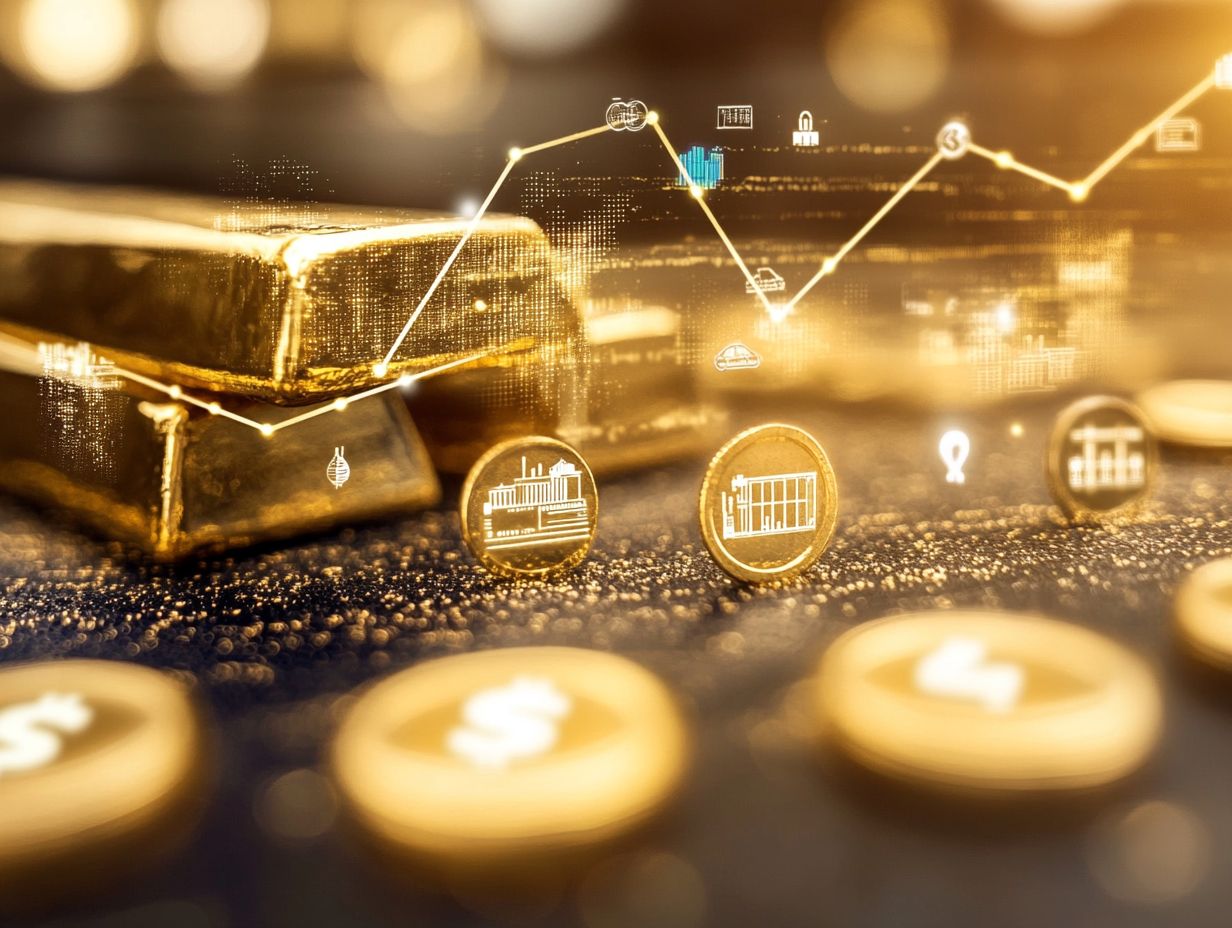
Gold prices are influenced by various factors, including global economic conditions, political events, interest rates, and investor demand. Changes in any of these factors can lead to fluctuations in the price of gold.
How do economic conditions impact the price of gold?
Economic conditions, such as inflation, deflation, and overall economic growth, can significantly impact the price of gold. When conditions are unstable, investors tend to turn to gold as a safe-haven investment, driving up its price.
What role do political events play in gold price fluctuations?
Political events, both domestic and international, can majorly impact the price of gold. For example, uncertainty surrounding elections or geopolitical tensions can lead investors to seek gold, causing its price to rise.
How do interest rates affect the price of gold?
Interest rates and the price of gold have an inverse relationship. When interest rates are low, holding gold costs less, making it a more appealing investment.
When interest rates are high, investors often seek assets with better returns, which can push gold prices down.
What is the effect of investor demand on gold prices?
Investor demand plays a crucial role in the price of gold. High demand usually leads to higher prices, often driven by economic uncertainty or global events.
People also invest more in gold when they explore alternative investments.
How do gold price fluctuations impact the economy?
Gold price changes can impact the economy positively and negatively. A rise in gold prices might indicate economic instability, causing consumer confidence to drop.
Conversely, lower gold prices can help businesses buy gold more affordably, which may boost economic growth!










